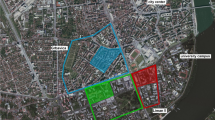Abstract
A highly influential but often underemphasized determinant of residential satisfaction is how residents perceive and feel about their neighborhoods. In this study, factors representing different aspects of residents' neighborhoods were identified and examined in relation to their overall assessment of their homes and neighborhoods. Relationships among neighborhood aspects and overall housing and neighborhood assessments were examined separately for residents of conventional homes, mobile homes, and apartments. Results based on all residents indicated that evaluations of neighborhood aspects were unrelated to housing satisfaction, but were moderately related to positive sentiments and satisfaction with the neighborhood. Separate analyses by housing type revealed that neighborhood perceptions of apartment residents were influential in affecting housing satisfaction. For all residents, the neighborhood's attractiveness and pleasant-friendliness were the most important determinants of neighborhood acceptance and satisfaction. The results also indicated that despite sharing similar determinant patterns of neighborhood acceptance with the other two housing type groups, the basis for mobile home residents' evaluations was considerably less related to the factors identified as influential. The findings indicated that different neighborhood factors formed the basis for differences in overall housing and neighborhood satisfaction among residents living in the three housing types. However, since the type of housing does not by itself define a neighborhood, the differences that were found need to be considered in the larger context of other components of a neighborhood like economic and community characteristics typically associated with a specific structure type.
Similar content being viewed by others
Bibliography
Campbell, A., P. E.Converse, and W. L.Rodgers: 1976, The Quality of American Life: Perceptions, Evaluations and Satisfactions (Russell Sage Foundation, New York).
Connerly, C. E. and R. W.Marans: 1985, ‘Comparing two global measures of perceived neighborhood quality’, Social Indicators Research 17, pp. 29–47.
Gray, G. E., G. G.Shelton, and K. J.Gruber: 1980, ‘The relevance of manufactured housing to the needs of low income families’, The Research Bulletin Series (North Carolina Agricultural and Technical State University, Greensboro, North Carolina).
Harris, C. M.: 1976, ‘The measurement of quality in housing and its relationship to housing satisfaction’, Housing Educators Journal 3, pp. 7–13.
Hartman, C. W.: 1963, ‘Social values and orientations’, Journal of Social Issues 19, pp. 113–121.
Haywood, G.: 1977, ‘Housing research and the concept of home’, Housing Educators Journal 4, pp. 7–12.
Lindamood, S.: 1976, ‘Determinants of consumer acceptance of mobile homes: Community housing and public policy implications’, Proceedings of the International Symposium on Housing Problems (Atlanta, Georgia) 1, pp. 622–636.
McCray, J. W., and S. S.Day: 1977, ‘Housing values, aspirations, and satisfactions as indicators of housing needs’, Home Economics Research Journal 5, pp. 244–254.
Moore, G. N., and M. W.Crocker: 1976, ‘Home owner satisfactions: Manufactured houses versus conventional houses’, Housing and Society 6, pp. 206–217.
Mukherjee, M. R.: 1980, ‘Residents' attitudes toward their neighborhood’, Housing Educators Journal, Special Issue: Proceedings of the 1980 Annual Conference of Housing Educators, pp. 147–152.
Pike, R. A., and A. C.Stubbs: 1978, ‘Implications of mobile home living relative to conventional site built housing for southern rural low-income families’, Housing and Society, Special Issue: Proceedings of the Annual Conference of Housing Educators 5, pp. 32–34.
Russ-Eft, D.: 1979, ‘Identifying components comprising neighborhood quality of life’, Social Indicators Research 6, pp. 349–372.
Shelton, G. G., K. J.Gruber, and D. D.Godwin: 1983, ‘The effect of housing type on the quality of living: A comparison of residents of conventional homes, mobile homes, and apartments in rural North Carolina’, The Research Bulletin Series (North Carolina Agricultural and Technical State University, Greensboro, North Carolina).
SPSS-X User's Guide: 1983, (McGraw-Hill, Highstown, NJ).
Stewart, K. K., and C.McKown: 1977, ‘Determinants of housing satisfaction in rural low-income families’, Housing Educators Journal 4, pp. 33–39.
Author information
Authors and Affiliations
Additional information
Because it is often not possible to apply a strict geophysical description to define what constitutes a neighborhood, it is necessary to define a neighborhood in terms of its residents and the similarities of culture, social status, ethnicity, and common bonds they might share (Mukherjee, 1980; Russ-Eft, 1979). The concept of “neighborhood” like that of “home” can take on many meanings to different people and one definition however broad or general may still be inadequate to account for some resident's conceptualization of what they consider to be their neighborhood (Hayward, 1977). Consequently, it is important to recognize that whatever definition of neighborhood is applied it is likely to have some conceptual and perceptual limitation. In this study, to avoid imposing a limiting definition of neighborhood on respondents, no attempt was made to strictly define neighborhood in terms of physical or psychosocial boundaries. Respondents were asked to make their evaluations based on their own conceived notion of what constituted their neighborhood.
Rights and permissions
About this article
Cite this article
Gruber, K.J., Shelton, G.G. Assessment of neighborhood satisfaction by residents of three housing types. Soc Indic Res 19, 303–315 (1987). https://doi.org/10.1007/BF00300363
Received:
Issue Date:
DOI: https://doi.org/10.1007/BF00300363




